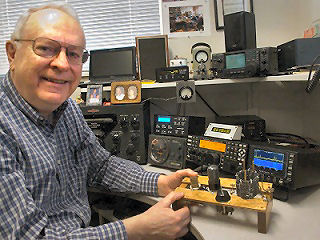 |
W4TVI James A. Hall Sr Boise, ID QCWA # 25579 Chapter 201 |
Rig is an Elecraft K3 with KPA500 running 500 watts and a SteppIR 3 element yagi 11 meters above ground. I mostly operate CW and enjoy both DX and rag chewing. Received my first license (Novice - WN4TVI) at the age of 14 in 1951. QTH was Halifax, VA. In the above picture I'm holding my first rig (6V6 xtal oscillator from the 1951 ARRL Handbook) in front of my K3. Quite a contrast between the two rigs!
Got my General Class license (W4TVI) in 1952. Since I now live in Boise, Idaho and have no plans to return to W4 land, I traded my original W4TVI call for a W7TVI vanity call in 2002. This change never felt right so I traded back for my original W4TVI call in 2004.
I graduated from NC State University with a BS degree in Electrical Engineering in 1959 and went to work for GE Communication Products Division (Lynchburg, VA). Designed solid state video and 70 MHz IF amplifiers, microwave frequency control systems, and high power, solid state, wideband FM microwave signal sources. Received a MS degree in Physics from Lynchburg College (VA) in 1971.
In 1972 joined the Microwave Division of Hewlett Packard (HP) in Palo Alto, CA. My first HP project was to design a 2.6GHz Satellite TV Receiver for NASA. The design was basically a Tuned RF (TRF)FM receiver requiring over 100 dB of gain, AM limiting, AGC and FM discriminator all at 2.6GHz. All circuits utilized microwave integrated circuit technology resulting in a very compact design. My next project was the HP8660C Microwave Signal Generator which covered the frequency range of 1 to 2600MHz and was completed in 1976.
I then moved to the HP Boise (Idaho) Division to lead the design of HP's first Laser Printer (HP2680A). It worked with the HP3000 minicomputer, printed at 45 pages per minute, sold for $115,000 and was introduced to the market in 1980. Although hard to believe today, it was quite revolutionary at the time. I next led the design of the desktop HP LaserJet Printer. It printed at 8 pages per minute, sold for $3,500 and was introduced to the market in 1984. It was truly a breakthrough product and the perfect companion to the recently introduced IBM PC. Sale volumes exceeded our wildest dreams! From that point forward my engineering team designed many follow-on LaserJet products with ever improving performance at lower cost. By the time I retired from HP in 2000, the LaserJet product line was producing billions of dollars of revenue for HP each year. I was very fortunate to participate in creating such a successful product line for HP.
November 16, 2014